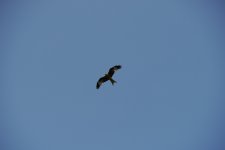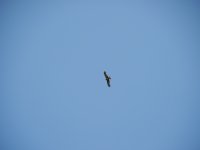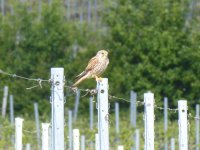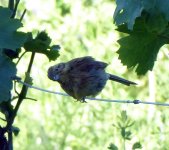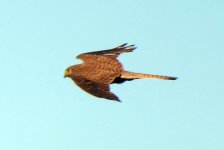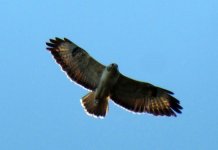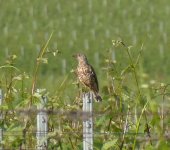Classick
Active member

Dear all,
Please excuse that this thread might seem a bit redundant, as there are many similar threads out there, but still ... here's another plea for help concerning a photo camera for birding.
I do currently have a camera: a Lumix DMC-GH2 with a first generation Panasonic 14-140 superzoom lens. I've been able to take relatively nice pictures of birds at the feeder where the distance is not that big, but when outdoors this combination has its limits. I've been able to capture birds of prey like Buteo buteo or Milvus milvus which were sufficient for IDing the birds, but the circumstances (lighting etc.) have to be right and of course the quality is only so-so. One issue is that I have not yet grasped how aperture and so on work together. I am sure that I could get better results out of the GH2 if I did understand and employ these photography basics and applied them with appropriate settings on my GH2, but I also somehow feel that this camera model dating to 2010 might be a bit ... outdated. At least it has been surpassed by many successor generations of digital cameras.
Still: one option might be to better grasp the aforementioend photography basics and get a used (first generation) Panasonic 100-300 tele (the 100-400 is out of my financial league). Or maybe this is not a good option after all?
I recently had the opportunity to shoot with a DSLR and a 150-600 lens. I could of course immediately feel and see the difference to my GH2 setup. But the price of such a combo and also the weight to be lugged around are off-putting. When birding, I have 8.5x42 binos attached to a harness as my primary optical device. Below the harness I have the GH2 in a bag or, when visiting my parents, their Lumix TZ71 (which has been o.k. for taking photos to ID birds but of course also has its limitations -- but the low weight is a plus of course). Sometimes I would also have the option to use a Apo-Televid 77 spotting scope (so far, though, I have only used it from a static position but never lugged it around "in the field"), so a DSLR with a large lens would simply be too much.
Also, I am not looking to win any bird photography contests. I do want to take relatively nice pictures, but I am not a photographer first but a birdwatching person who also likes to take pictures. Also, I usually roam around when birding; I might peruse an observation hut in the future, but I am not planning to get a tent and wait in a single locale for hours on end to take "the perfect shot".
So, naturally, I have come across bridge cameras and the usual suspects as a possible route to take, one of them being the Nikon P950 (or P900 as a used option -- the P1000 might be too heavy) of course. It has a large zoom which would be, I guess, helpful to take pictures of more far-away subjects like birds of prey (I like to take photos of birds of prey circling their way up or sitting on trees and the like looking for prey). But it seems that the price to pay for the large Nikon zoom -- a smaller sensor -- comes with diminished low-light capabilities and also problems to catch moving targets. As I also like to watch, and take pictures of, central European songbirds who are known to be quite agile at times, I wonder if the Nikons are the way to go? Concerning light: I will not go out birding during a downpour, but Germany is known for often being overcast -- also, dusk and dawn are also not always sunny. I recently held a P900 in my hands but that was in the parking lot after birding, so my hands-on experience concerning this camera is very limited.
I've also come across the various Lumix bridge cameras, but they seem to play a bit of rock paper scissors, each with their PROs and CONs, ranging from a better sensor to a larger zoom. Of course, as with almost everything in life and in this case with optics or photo cameras specifically, any choice would be a compromise and to the detriment of one or more capabilities -- which does not make the choice easier ...
And then there's of course other companies too. I've read quite often that people are happy with the Sony RX 10 M 4 for birding, but that camera is out of my financial ballpark.
Well, as we say in Germany, maybe I am looking for the elusive "Eier legende Wollmilchsau" (similar to the jack of all trades in English) -- but I am well aware that there is no cheap camera that can do it all perfectly. But maybe your comments could be of help? Thanks so much in advance for your replies!
P.S.: I am well aware that I should eventually test any possible candidate prior to a purchase.
Please excuse that this thread might seem a bit redundant, as there are many similar threads out there, but still ... here's another plea for help concerning a photo camera for birding.
I do currently have a camera: a Lumix DMC-GH2 with a first generation Panasonic 14-140 superzoom lens. I've been able to take relatively nice pictures of birds at the feeder where the distance is not that big, but when outdoors this combination has its limits. I've been able to capture birds of prey like Buteo buteo or Milvus milvus which were sufficient for IDing the birds, but the circumstances (lighting etc.) have to be right and of course the quality is only so-so. One issue is that I have not yet grasped how aperture and so on work together. I am sure that I could get better results out of the GH2 if I did understand and employ these photography basics and applied them with appropriate settings on my GH2, but I also somehow feel that this camera model dating to 2010 might be a bit ... outdated. At least it has been surpassed by many successor generations of digital cameras.
Still: one option might be to better grasp the aforementioend photography basics and get a used (first generation) Panasonic 100-300 tele (the 100-400 is out of my financial league). Or maybe this is not a good option after all?
I recently had the opportunity to shoot with a DSLR and a 150-600 lens. I could of course immediately feel and see the difference to my GH2 setup. But the price of such a combo and also the weight to be lugged around are off-putting. When birding, I have 8.5x42 binos attached to a harness as my primary optical device. Below the harness I have the GH2 in a bag or, when visiting my parents, their Lumix TZ71 (which has been o.k. for taking photos to ID birds but of course also has its limitations -- but the low weight is a plus of course). Sometimes I would also have the option to use a Apo-Televid 77 spotting scope (so far, though, I have only used it from a static position but never lugged it around "in the field"), so a DSLR with a large lens would simply be too much.
Also, I am not looking to win any bird photography contests. I do want to take relatively nice pictures, but I am not a photographer first but a birdwatching person who also likes to take pictures. Also, I usually roam around when birding; I might peruse an observation hut in the future, but I am not planning to get a tent and wait in a single locale for hours on end to take "the perfect shot".
So, naturally, I have come across bridge cameras and the usual suspects as a possible route to take, one of them being the Nikon P950 (or P900 as a used option -- the P1000 might be too heavy) of course. It has a large zoom which would be, I guess, helpful to take pictures of more far-away subjects like birds of prey (I like to take photos of birds of prey circling their way up or sitting on trees and the like looking for prey). But it seems that the price to pay for the large Nikon zoom -- a smaller sensor -- comes with diminished low-light capabilities and also problems to catch moving targets. As I also like to watch, and take pictures of, central European songbirds who are known to be quite agile at times, I wonder if the Nikons are the way to go? Concerning light: I will not go out birding during a downpour, but Germany is known for often being overcast -- also, dusk and dawn are also not always sunny. I recently held a P900 in my hands but that was in the parking lot after birding, so my hands-on experience concerning this camera is very limited.
I've also come across the various Lumix bridge cameras, but they seem to play a bit of rock paper scissors, each with their PROs and CONs, ranging from a better sensor to a larger zoom. Of course, as with almost everything in life and in this case with optics or photo cameras specifically, any choice would be a compromise and to the detriment of one or more capabilities -- which does not make the choice easier ...
And then there's of course other companies too. I've read quite often that people are happy with the Sony RX 10 M 4 for birding, but that camera is out of my financial ballpark.
Well, as we say in Germany, maybe I am looking for the elusive "Eier legende Wollmilchsau" (similar to the jack of all trades in English) -- but I am well aware that there is no cheap camera that can do it all perfectly. But maybe your comments could be of help? Thanks so much in advance for your replies!
P.S.: I am well aware that I should eventually test any possible candidate prior to a purchase.






